Notes: There is some uncertainty about the early years of this station. It first appeared in Bradshaw as ‘Wark’ in July 1859 about a decade after the line opened, but the station building closely resembles that at Carham, the next on the way to Kelso which opened with the line or very soon after. In his chapter on the Kelso Branch in Addyman (Ed, 2011) J C Dean refers to a temporary station at Wark – perhaps wisely, no date is offered for its opening - which was replaced by a permanent one, so the building that survives today must have been constructed sometime after its neighbour at Carham. The building was possibly designed by John and Benjamin Green. These architects created the series of wonderful station buildings on the East Coast main line (ECML) in Northumberland, a number of which survive today, but their brief was to be less ambitious when the Kelso Branch station designs were commissioned.
 As noted above, when the station opened it was known as Wark, named after the village about ¾-mile to the north. Almost coinciding with this station’s appearance in Bradshaw, another of this name, also in Northumberland, opened on the Border Counties Railway between Hexham and Reedsmouth. The North British Railway (whose station at Kelso was used by the North Eastern Railway [NER] trains from Berwick) had a strong interest in the Border Counties from the outset and quickly took it over. The NER was disinclined to share any of its stations’ names with another company, or to repeat a name in its own system, so to avoid confusion the station on the Kelso branch was eventually renamed, taking the name ‘Sunilaws’ from a nearby farm - although it appears that the spelling was incorrect. On OS maps of 1863 and 1899 the farm is ‘Sunnylaws’ but by the edition of 1924 the farm seems to have adopted the railway spelling. To make matters still more confusing, Sunilaws was actually in the parish of Carham – whilst Carham station was in the parish of Sprouston. As noted above, when the station opened it was known as Wark, named after the village about ¾-mile to the north. Almost coinciding with this station’s appearance in Bradshaw, another of this name, also in Northumberland, opened on the Border Counties Railway between Hexham and Reedsmouth. The North British Railway (whose station at Kelso was used by the North Eastern Railway [NER] trains from Berwick) had a strong interest in the Border Counties from the outset and quickly took it over. The NER was disinclined to share any of its stations’ names with another company, or to repeat a name in its own system, so to avoid confusion the station on the Kelso branch was eventually renamed, taking the name ‘Sunilaws’ from a nearby farm - although it appears that the spelling was incorrect. On OS maps of 1863 and 1899 the farm is ‘Sunnylaws’ but by the edition of 1924 the farm seems to have adopted the railway spelling. To make matters still more confusing, Sunilaws was actually in the parish of Carham – whilst Carham station was in the parish of Sprouston.
The two passenger platforms at Sunilaws were staggered either side of the level crossing. The up (Berwick-bound) platform, 88yd in length, was south-west of the crossing and the longer down platform (99yd) was north-east. At the neighbouring Carham station the platforms were on the opposite sides of the level crossing: up to the north-east and down to the south-west. The stationmaster’s house and offices were on the up side, close to the crossing. Although the office range was on the platform, facing the ramp, in front of the house was a track-level path from the wicket gate at the level crossing. The two-storey house was of smooth but uncoursed stone, with a dormer window facing the platform, adjoined to the north-east by a taller building, of simpler design. One house was possibly the residence of the stationmaster and the other of the porter – an arrangement found at some of the large station buildings on the ECML. A single-storey office range, notable for its extremely tall chimneystack, extended south-west from the station house. On the down platform an enclosed timber hut close to the crossing appears to have been the only shelter. Between this building and the crossing was the signal box, an N4 design with a brick base, constructed in 1901; it was equipped with a McKenzie & Holland 26-lever frame and gate wheel. The box was the second at the station, but little is known of the first, opened c1880, including its precise location. The coal yard at Sunilaws was on the up side of the tracks, facing the down platform and provided with a weigh office and loading bank. Other goods traffic was handled at a siding on the opposite side of the level crossing, on the down side and facing the up platform. Here, too, there was a loading bank. A terrace of four railwaymen’s cottages stood behind the down platform.

The goods facilities at Sunilaws station were shown in the Railway Clearing House Handbook of 1904 to be equipped to handle general goods, livestock and horse boxes / prize cattle vans, but there was no crane. In 1913 the local area, possessing arable and pastoral land of good quality, provided the 560 tons of barley, 203 tons of potatoes and 114 wagons of livestock that were dispatched from Sunilaws station. The farmland was lightly populated, with only 228 people served (according to NER statistics for 1911), much of whom will have lived in the village of Wark almost a mile distant. In the same year only 2,680 tickets were issued at the station.
Bradshaw of February 1863 shows the following passenger service at Wark station (as it was then called). The four weekday trains in each direction called at all stations, regardless of their importance, except that calls at Twizell were as required. The Sunday morning down train made request stops at Twizell, Sunilaws, Carham and Sprouston but was booked to stop at the other stations between Berwick and Kelso.
Wark station:
February 1863
Up trains: weekdays |
Destination |
Down trains: weekdays |
Destination |
7.31am |
Berwick |
9.28am |
Kelso |
10.31am |
Berwick |
2.28pm |
Kelso |
3.26pm |
Berwick |
5.14pm |
Kelso |
7.26pm |
Berwick |
7.41pm |
Kelso |
Up trains: Sunday |
|
Down trains: Sunday |
|
9.05am |
Berwick |
7.44am ‡ |
Kelso |
7.45pm |
Berwick |
5.14pm |
Kelso |
‡ Stops when required: approximate time
The 1887 timetable shows a more frequent service on weekdays:
Up trains: weekdays
August 1887 |
Destination |
Down trains: weekdays |
Destination |
8.21am |
Berwick |
9.18am |
Kelso |
10.16am |
Berwick |
12.13m |
Kelso |
12.56pm |
Berwick |
2.53pm |
Kelso |
3.36pm |
Berwick |
5.23pm |
Kelso |
7.56pm |
Berwick |
7.29pm |
Kelso |
- |
- |
8.29pm |
Kelso |
Up trains: Sunday |
Destination |
Down trains: Sunday |
Destination |
9.31am |
Berwick |
8.13am |
Kelso |
8.01pm |
Berwick |
6.13pm |
Kelso |
 NER records show that the first stationmaster of Sunilaws in the twentieth century was Mr W Windus who was in post until November 1900. His replacement was Mr A McKenzie whose tenure lasted for only a few months; Mr J Forster was in place from the end of February 1901 until November 1903. In December 1903 Mr R Richardson became stationmaster and he held this post until November 1913; he retired at the end of the year. Mr W Harrison was his replacement, and his term of office extended to May 1917. After a short interregnum Mr H Pardoe was appointed in July 1917, and after his departure in June 1920 a Mr Purves became stationmaster in September 1920. While he was in office the station was transferred from the NER to the newly formed London & North Eastern Railway on 1 January 1923. The timetable below shows a diminished service on the section of the branch between Coldstream and Kelso. NER records show that the first stationmaster of Sunilaws in the twentieth century was Mr W Windus who was in post until November 1900. His replacement was Mr A McKenzie whose tenure lasted for only a few months; Mr J Forster was in place from the end of February 1901 until November 1903. In December 1903 Mr R Richardson became stationmaster and he held this post until November 1913; he retired at the end of the year. Mr W Harrison was his replacement, and his term of office extended to May 1917. After a short interregnum Mr H Pardoe was appointed in July 1917, and after his departure in June 1920 a Mr Purves became stationmaster in September 1920. While he was in office the station was transferred from the NER to the newly formed London & North Eastern Railway on 1 January 1923. The timetable below shows a diminished service on the section of the branch between Coldstream and Kelso.
July 1920 Up trains: weekdays |
Destination |
Down trains: weekdays |
Destination |
10.16am |
Berwick |
9.22am |
Kelso |
3.41pm |
Berwick |
2.59pm |
Kelso |
7.31pm |
Berwick |
6.40pm |
Kelso |
Up trains: Sunday |
Destination |
Down trains: Sunday |
Destination |
9.51am |
Berwick |
9.05am |
Kelso |
7.31pm |
Berwick |
6.40pm |
Kelso |
During the LNER era it seems that Sunilaws station received little investment. It is likely that the company installed new nameboards, but no photographic evidence has been seen of this. The winter 1937/38 train departures in the table below include services operated by steam railcar (indicated by * ‘one class only’) as an economy measure. A particularly interesting feature is the arrival of the railcar from Berwick late on Saturday evenings to terminate at Sunilaws at 10.01pm; it sets off back to Berwick at 10.29pm. The choice of Sunilaws as terminus is curious. Was its purpose to enable the families in the remote station house and railway cottages at Sunilaws to enjoy some Saturday evening revelry in Berwick – with an option of returning promptly to Berwick if they wanted still more? Perhaps motor buses through the villages enabled inhabitants of Carham and Sprouston to enjoy the fleshpots of Berwick without the need for a train to serve them. It is not known how long this peculiar service to (and from) Sunilaws was provided; it is not shown in the summer 1938 timetable.
September 1937
Up trains: weekdays |
Destination |
Down trains: weekdays |
Destination |
10.15am |
Berwick |
9.24am |
Kelso |
12.47pm * |
Berwick |
12.08pm * |
Kelso |
3.20pm |
Berwick |
2.35pm |
Kelso |
6.53pm * |
Berwick |
6.03pm |
St Boswells |
10.29pm SO § * |
Berwick |
- |
- |
Sunday: no trains |
|
Sunday: no trains |
|
SO Saturday only § Train starts here * One class only
As to stationmasters, Mr Purves, who had been appointed in 1920 was in post at Sunilaws until March 1936. At some time during this period he was given charge of Carham station too. His successor, Mr G Whitehead, also had this joint responsibility. He left the post in August 1938, and it seems that from this time Sunilaws became the responsibility of the stationmaster of Coldstream and Sprouston’s stationmaster was given the job of supervising Carham.
 At nationalisation on 1 January 1948 Sunilaws became part of British Railways (BR) North Eastern Region (NE). It seems unlikely that any buses would have stopped outside Sunilaws station, but they did operate on the main road through Wark that ran parallel to the railway, so Wark residents would have little reason to use their ‘local’ station. Early in the BR era the viability of the passenger services on the Berwick – Kelso – St Boswells railway was scrutinised British Railways. The withdrawal of all trains running between St Boswells and Berwick was considered but because of the heavy parcels traffic, consisting mainly of fresh meat, game and poultry, it was decided not to effect a complete closure. However it was proposed to save £7,744 a year by closing Velvet Hall, Twizell, Sunilaws, Sprouston and Carham stations, all on the former NER section, and substantially reducing the number of trains. Norham and Coldstream stations would remain open. It was reported that annual revenue from Sunilaws amounted to £217, Velvet Hall £125, and Twizell £66 and the number of passengers travelling daily in an October census were four, six and two respectively. Four trains on weekdays still operated each way between Berwick and Kelso, and the last months’ timetable for Sunilaws is shown below. At nationalisation on 1 January 1948 Sunilaws became part of British Railways (BR) North Eastern Region (NE). It seems unlikely that any buses would have stopped outside Sunilaws station, but they did operate on the main road through Wark that ran parallel to the railway, so Wark residents would have little reason to use their ‘local’ station. Early in the BR era the viability of the passenger services on the Berwick – Kelso – St Boswells railway was scrutinised British Railways. The withdrawal of all trains running between St Boswells and Berwick was considered but because of the heavy parcels traffic, consisting mainly of fresh meat, game and poultry, it was decided not to effect a complete closure. However it was proposed to save £7,744 a year by closing Velvet Hall, Twizell, Sunilaws, Sprouston and Carham stations, all on the former NER section, and substantially reducing the number of trains. Norham and Coldstream stations would remain open. It was reported that annual revenue from Sunilaws amounted to £217, Velvet Hall £125, and Twizell £66 and the number of passengers travelling daily in an October census were four, six and two respectively. Four trains on weekdays still operated each way between Berwick and Kelso, and the last months’ timetable for Sunilaws is shown below.
February 1955 Up trains: weekdays |
Destination |
Down trains: weekdays |
Destination |
7.47am |
Berwick-upon-Tweed |
7.13am |
St Boswells |
9.45am |
Berwick-upon-Tweed |
10.00am |
St Boswells |
4.55pm |
Berwick-upon-Tweed |
4.09pm |
St Boswells |
8.14pm |
Berwick-upon-Tweed |
7.26pm |
St Boswells |
Sunday: no trains |
|
Sunday: no trains |
|
SO Saturday only SX Saturday excepted
The June 1955 table was essentially the same except that the 9.45am and 4.09pm departures would be retimed on Saturday only. Passenger trains called for the last time at Sunilaws on Saturday 2 July 1955 and the station was formally closed the following Monday. As it served a wide rural area, goods and coal traffic continued to be handled until 29 March 1965, the day when the line was closed entirely. Sunilaws signal box remained in use until this date. The down line through Sunilaws station was lifted in early 1966 by Campbell’s of Airdrie; the up line was removed in 1969/70.
Sunilaws station remains remarkably well preserved, with both passenger platforms in place and remains of both the up and down side loading banks. The stationmaster’s house and office are in place as are the, now modernised, railway cottages on the opposite side of the road and trackbed. The signal box and shelter on the down platform have been demolished.
Tickets from Michael Stewart. Route map drawn by Alan Young
Click here for a brief history of the
Tweedmouth - St Boswells line
To see other stations on the Tweedmouth - St Boswells line click on the station name: Tweedmouth, Velvet Hall, Norham, Twizell, Coldstream, Carham, Sprouston, Kelso, Wallace Nick, Roxburgh, Rutherford & Maxton & St Boswells
See also Jedburgh branch: Kirkbank, Nisbet, Jedfoot & Jedburgh |

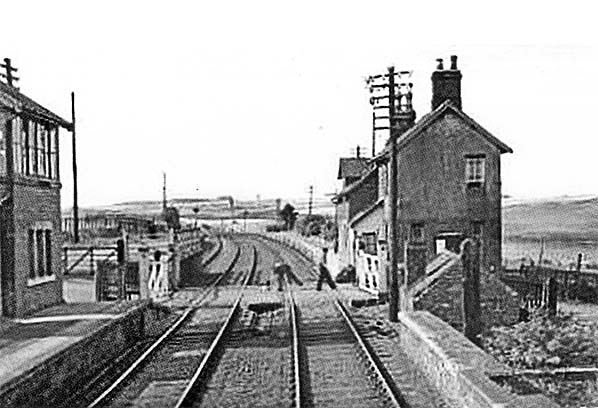

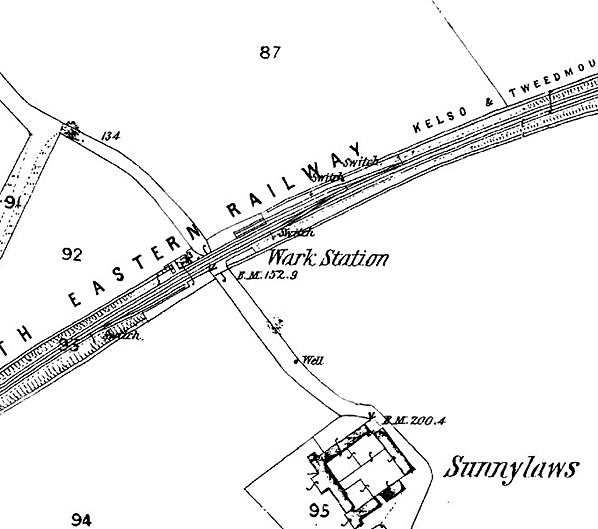
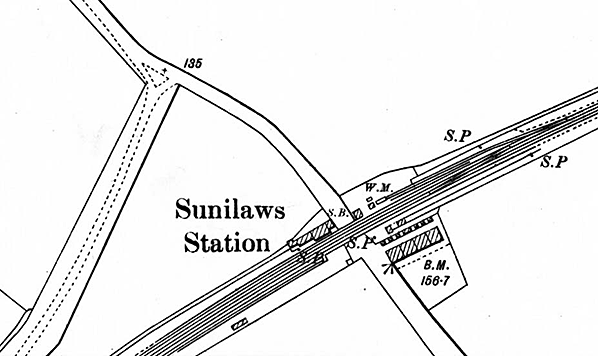
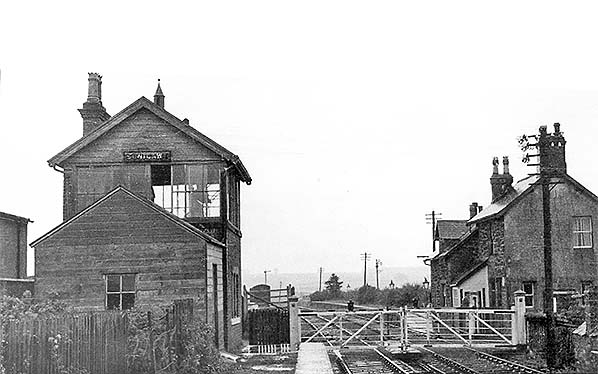
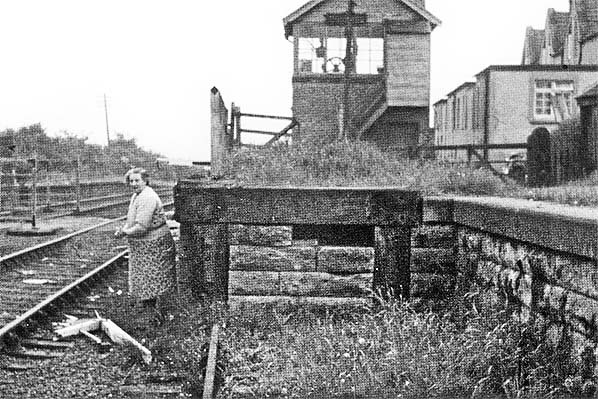
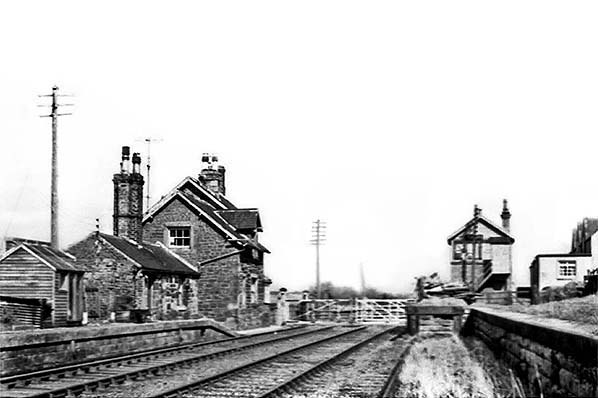
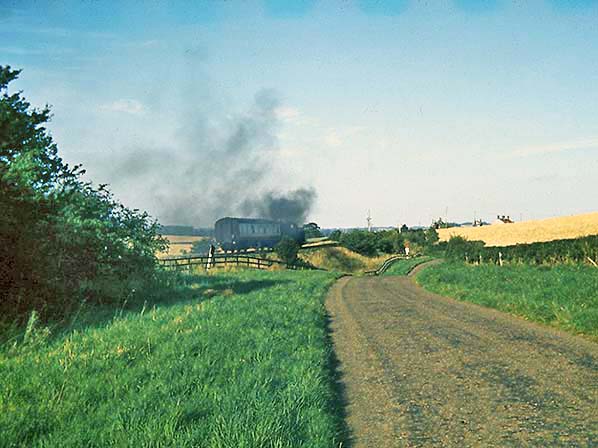
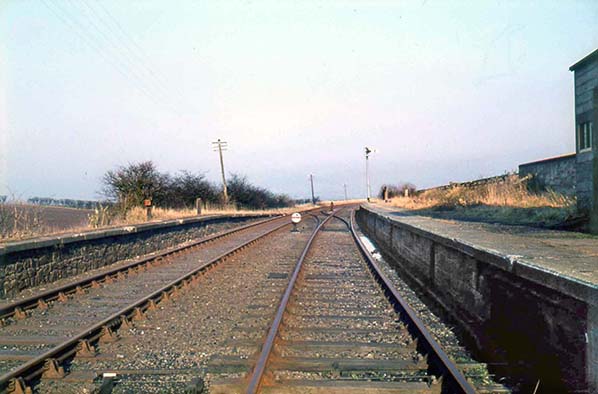
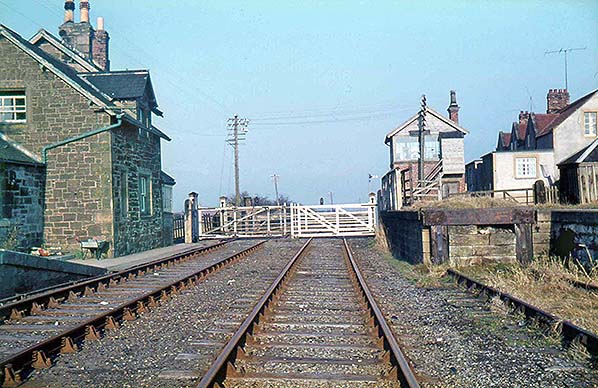
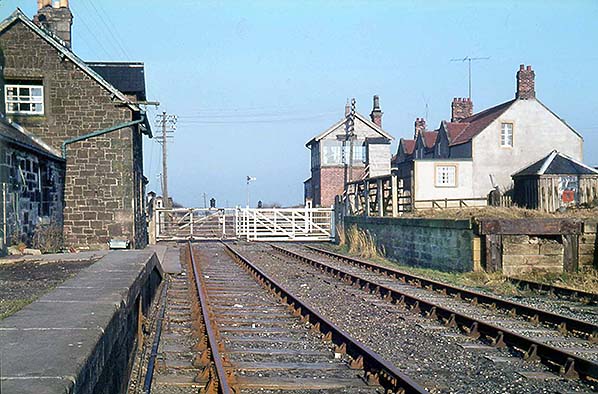 Looking north-east at Sunilaws station, probably in winter 1963-64. The stationmaster’s house and up platform ramp are on the left. To the right, this side of the crossing, are a goods siding and loading bank. Beyond the crossing are the signal box and a terrace of railway cottages.
Looking north-east at Sunilaws station, probably in winter 1963-64. The stationmaster’s house and up platform ramp are on the left. To the right, this side of the crossing, are a goods siding and loading bank. Beyond the crossing are the signal box and a terrace of railway cottages. As noted above, when the station opened it was known as Wark, named after the village about ¾-mile to the north. Almost coinciding with this station’s appearance in Bradshaw, another of this name, also in Northumberland, opened on the Border Counties Railway between Hexham and Reedsmouth. The North British Railway (whose station at Kelso was used by the North Eastern Railway [NER] trains from Berwick) had a strong interest in the Border Counties from the outset and quickly took it over. The NER was disinclined to share any of its stations’ names with another company, or to repeat a name in its own system, so to avoid confusion the station on the Kelso branch was eventually renamed, taking the name ‘Sunilaws’ from a nearby farm - although it appears that the spelling was incorrect. On OS maps of 1863 and 1899 the farm is ‘Sunnylaws’ but by the edition of 1924 the farm seems to have adopted the railway spelling. To make matters still more confusing, Sunilaws was actually in the parish of Carham – whilst Carham station was in the parish of Sprouston.
As noted above, when the station opened it was known as Wark, named after the village about ¾-mile to the north. Almost coinciding with this station’s appearance in Bradshaw, another of this name, also in Northumberland, opened on the Border Counties Railway between Hexham and Reedsmouth. The North British Railway (whose station at Kelso was used by the North Eastern Railway [NER] trains from Berwick) had a strong interest in the Border Counties from the outset and quickly took it over. The NER was disinclined to share any of its stations’ names with another company, or to repeat a name in its own system, so to avoid confusion the station on the Kelso branch was eventually renamed, taking the name ‘Sunilaws’ from a nearby farm - although it appears that the spelling was incorrect. On OS maps of 1863 and 1899 the farm is ‘Sunnylaws’ but by the edition of 1924 the farm seems to have adopted the railway spelling. To make matters still more confusing, Sunilaws was actually in the parish of Carham – whilst Carham station was in the parish of Sprouston.
 NER records show that the first stationmaster of Sunilaws in the twentieth century was Mr W Windus who was in post until November 1900. His replacement was Mr A McKenzie whose tenure lasted for only a few months; Mr J Forster was in place from the end of February 1901 until November 1903. In December 1903 Mr R Richardson became stationmaster and he held this post until November 1913; he retired at the end of the year. Mr W Harrison was his replacement, and his term of office extended to May 1917. After a short interregnum Mr H Pardoe was appointed in July 1917, and after his departure in June 1920 a Mr Purves became stationmaster in September 1920. While he was in office the station was transferred from the NER to the newly formed London & North Eastern Railway on 1 January 1923. The timetable below shows a diminished service on the section of the branch between Coldstream and Kelso.
NER records show that the first stationmaster of Sunilaws in the twentieth century was Mr W Windus who was in post until November 1900. His replacement was Mr A McKenzie whose tenure lasted for only a few months; Mr J Forster was in place from the end of February 1901 until November 1903. In December 1903 Mr R Richardson became stationmaster and he held this post until November 1913; he retired at the end of the year. Mr W Harrison was his replacement, and his term of office extended to May 1917. After a short interregnum Mr H Pardoe was appointed in July 1917, and after his departure in June 1920 a Mr Purves became stationmaster in September 1920. While he was in office the station was transferred from the NER to the newly formed London & North Eastern Railway on 1 January 1923. The timetable below shows a diminished service on the section of the branch between Coldstream and Kelso. At nationalisation on 1 January 1948 Sunilaws became part of British Railways (BR) North Eastern Region (NE). It seems unlikely that any buses would have stopped outside Sunilaws station, but they did operate on the main road through Wark that ran parallel to the railway, so Wark residents would have little reason to use their ‘local’ station. Early in the BR era the viability of the passenger services on the Berwick – Kelso – St Boswells railway was scrutinised British Railways. The withdrawal of all trains running between St Boswells and Berwick was considered but because of the heavy parcels traffic, consisting mainly of fresh meat, game and poultry, it was decided not to effect a complete closure. However it was proposed to save £7,744 a year by closing Velvet Hall, Twizell, Sunilaws, Sprouston and Carham stations, all on the former NER section, and substantially reducing the number of trains. Norham and Coldstream stations would remain open. It was reported that annual revenue from Sunilaws amounted to £217, Velvet Hall £125, and Twizell £66 and the number of passengers travelling daily in an October census were four, six and two respectively. Four trains on weekdays still operated each way between Berwick and Kelso, and the last months’ timetable for Sunilaws is shown below.
At nationalisation on 1 January 1948 Sunilaws became part of British Railways (BR) North Eastern Region (NE). It seems unlikely that any buses would have stopped outside Sunilaws station, but they did operate on the main road through Wark that ran parallel to the railway, so Wark residents would have little reason to use their ‘local’ station. Early in the BR era the viability of the passenger services on the Berwick – Kelso – St Boswells railway was scrutinised British Railways. The withdrawal of all trains running between St Boswells and Berwick was considered but because of the heavy parcels traffic, consisting mainly of fresh meat, game and poultry, it was decided not to effect a complete closure. However it was proposed to save £7,744 a year by closing Velvet Hall, Twizell, Sunilaws, Sprouston and Carham stations, all on the former NER section, and substantially reducing the number of trains. Norham and Coldstream stations would remain open. It was reported that annual revenue from Sunilaws amounted to £217, Velvet Hall £125, and Twizell £66 and the number of passengers travelling daily in an October census were four, six and two respectively. Four trains on weekdays still operated each way between Berwick and Kelso, and the last months’ timetable for Sunilaws is shown below.
 Home Page
Home Page